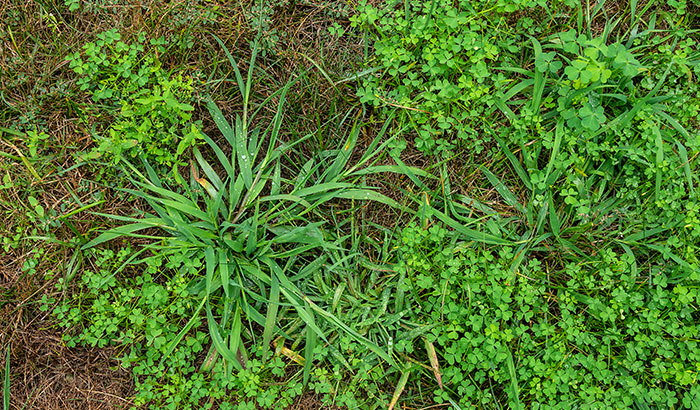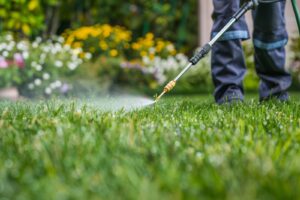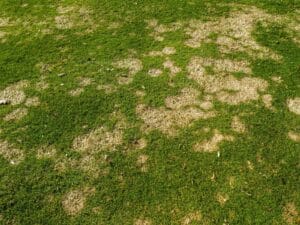Ah, the battle against crabgrass. If you’ve ever found yourself frustrated by these pesky invaders taking over your lawn, you’re not alone. Crabgrass is a common nuisance that can quickly turn a beautiful lawn into a weedy mess.
But fear not! In this blog, we’ll explore effective strategies to keep crabgrass from coming back and help you reclaim the lush green yard you deserve. From proper lawn maintenance to herbicide application and manual weed control, we’ll cover all the essential steps you need to take.
So, put on your gardening gloves, and let’s dive in to banish crabgrass once and for all!
Understanding Crabgrass
When it comes to winning the title of the most annoying lawn invader, crabgrass is a strong contender. This pesky weed is an annual grass that reproduces through seeds, making it a formidable opponent in your quest for a pristine lawn.
Crabgrass is characterized by its low-growing, spreading nature and its distinctive wide blades that resemble crab legs—hence the name. It starts as a small seedling and quickly develops into a sprawling plant, forming a dense mat that can smother your desirable turfgrass.
The life cycle of crabgrass typically begins in the spring when the soil temperature reaches around 55°F (13°C). This is the signal for those dormant crabgrass seeds lying in wait to germinate and begin their invasion.
Once the seeds sprout, they rapidly grow and spread, stealing valuable nutrients and water from your desired grass. As the temperatures cool in the fall, crabgrass begins to produce seed heads, ensuring its offspring will torment your lawn the following year.
To effectively remove crabgrass, it’s crucial to understand the conditions that make it thrive. Unfortunately, crabgrass seems to have an uncanny ability to adapt and survive, but it does have some preferred conditions that boost its growth.
- Sunlight: Crabgrass thrives in areas with plenty of sunlight. It loves to bask in the sun, so shady spots in your lawn are usually safe from its clutches.
- Warmth: Crabgrass is a warm-season grass, meaning it enjoys the heat. It flourishes in temperatures between 75°F and 90°F (24°C and 32°C), which makes it a common nuisance during the summer months.
- Bare Soil or Thin Grass: Crabgrass is opportunistic and often takes advantage of bare patches or thin areas in your lawn. If your lawn is sparse or has bare spots, it provides the perfect opportunity for crabgrass to establish itself.
- Moisture: While crabgrass can tolerate drought conditions, it prefers moist soil. Overwatering or poor drainage can create the ideal environment for crabgrass to proliferate.
- Neglected Lawns: Lawns that are poorly maintained or neglected are more susceptible to crabgrass infestations. Lack of regular mowing, fertilization, and weed control allows crabgrass to take hold and spread unchecked.
Understanding these conditions is vital in developing a strategy to prevent crabgrass from taking over your lawn. Addressing these factors head-on can significantly reduce the likelihood of crabgrass rearing its unwelcome head in your yard.
Steps to Prevent Crabgrass from Coming Back
Proper Lawn Maintenance
Maintaining a healthy lawn is the first line of defense against crabgrass. Follow these practices to keep your lawn in top shape.
- Regular mowing helps to control weed growth, including crabgrass. Set your mower to the recommended height for your grass type, usually around 2-3 inches. Avoid cutting the grass too short, as this can weaken it and allow crabgrass to take hold.
- Water deeply but infrequently to encourage deep root growth in your desired grass. This helps the lawn compete with crabgrass for nutrients and water.
- Proper fertilization provides the necessary nutrients for your grass to thrive, making it more resistant to crabgrass invasion. Conduct a soil test to determine any nutrient deficiencies and apply fertilizers accordingly. Also, maintain good soil health by aerating to improve drainage and reduce soil compaction and by regularly adding organic matter to promote a nutrient-rich environment for your grass.
Pre-Emergent Herbicides
Pre-emergent herbicides can be a powerful tool in your arsenal to prevent crabgrass from taking over your lawn. Pre-emergent herbicides are chemicals specifically designed to target crabgrass seeds before they germinate. These herbicides create a barrier in the top layer of soil, acting as a shield that prevents the seeds from sprouting and establishing themselves in your lawn.
Timing is crucial when it comes to using pre-emergent herbicides effectively. The ideal time to apply them is before the crabgrass seeds start to germinate. This typically occurs when the soil temperature reaches around 55°F (13°C). To determine the right timing for your area, you can consult local gardening resources or speak with a lawn care professional.
When choosing a pre-emergent herbicide, look for one that specifically targets crabgrass. Read the product label and ensure it is safe to use on your type of grass. Consider factors like the size of your lawn and the presence of other weeds when selecting the right herbicide. Follow the instructions on the label for application rates and techniques.
It’s essential to apply the herbicide evenly and at the recommended dosage. Water the treated area thoroughly afterward to activate the herbicide and ensure it reaches the soil where crabgrass seeds reside.
Remember, pre-emergent herbicides are preventive measures and work best when applied proactively. They form a protective shield, so it’s crucial to apply them before the crabgrass seeds begin to sprout.
Post-Emergent Herbicides
So, crabgrass managed to pop up despite your best efforts? Don’t worry; post-emergent herbicides can help you reclaim your lawn. Here’s what you need to know.
Post-emergent herbicides are specifically formulated to target crabgrass that has already sprouted and is actively growing. These herbicides contain chemicals that enter the plant’s leaves and disrupt its growth processes, ultimately causing it to wither and die. They can be a game-changer in your battle against crabgrass.
When it comes to post-emergent herbicides, there are two main types: selective and non-selective.
- Selective herbicides are designed to target specific weeds, such as crabgrass, while minimizing damage to your desired grass.
- Non-selective herbicides don’t discriminate and can kill any plant they come into contact with. It’s crucial to choose the right herbicide for your situation to avoid unintentional harm to your lawn.
Timing and proper application are key to maximizing the effectiveness of post-emergent herbicides. It’s important to avoid applying herbicides on windy days to prevent drift, which can harm nearby plants.
By using post-emergent herbicides strategically and following the recommended guidelines, you can target and eliminate existing crabgrass, helping your lawn regain its healthy and weed-free appearance.
However, keep in mind that post-emergent herbicides are best used as a spot treatment for small infestations. For larger areas or persistent crabgrass problems, it’s advisable to consult a lawn care professional who can provide personalized recommendations and assistance.
Manual Weed Control
Ah, the good old-fashioned way of dealing with crabgrass: manual weed control. Sometimes, getting your hands dirty is the best approach.
Hand-pulling or digging out crabgrass is an effective method, especially for smaller infestations or isolated patches. This method physically removes the weed from your lawn, preventing it from spreading and taking over your turf. It’s a straightforward and satisfying way to tackle the problem.
To hand-pull or dig out crabgrass effectively, follow these steps:
- Start by moistening the soil to make it easier to remove the weed.
- Use a hand trowel or a weeding tool to loosen the soil around the crabgrass plant.
- Grip the base of the crabgrass plant near the soil surface and gently pull upward, making sure to get the entire root system.
- Dispose of the removed crabgrass in a sealed bag or trash to prevent it from reseeding or spreading elsewhere.
Proper disposal of the removed crabgrass is crucial to prevent its reestablishment. Make sure to seal the crabgrass in a bag or trash to prevent the seeds from scattering. Avoid composting the weed unless you have a hot composting system that can kill the seeds.
While manual weed control can be effective for small areas, keep in mind that it may not be practical for large infestations or widespread crabgrass problems. It’s a labor-intensive method that requires regular monitoring and persistence. Combining manual removal with other preventive measures, such as proper lawn maintenance and the use of herbicides, can increase your chances of successfully keeping crabgrass at bay.
Additional Tips and Considerations
Preventing crabgrass from coming back requires a comprehensive approach. In addition to the previously mentioned strategies, consider the following tips and considerations:
- Avoid over-watering and excessive fertilization.
While proper watering and fertilization are essential for a healthy lawn, overdoing it can create favorable conditions for crabgrass to thrive. Excessive watering leads to shallow root growth and weakens your desired grass, making it more susceptible to crabgrass invasion.
Similarly, excessive fertilization can stimulate crabgrass growth. Follow recommended watering and fertilization guidelines for your specific grass type and adjust them based on weather conditions and soil moisture levels.
- Properly maintain garden bed and edges.
Crabgrass can find its way into your lawn through garden beds and edges, so it’s important to maintain them properly. Use edging materials to create a clear separation between your lawn and garden beds, preventing crabgrass from encroaching.
Regularly remove any weeds or crabgrass that appear in these areas, applying the same preventive measures as you do for your lawn.
- Practice good lawn hygiene and cleanliness.
A clean and well-maintained lawn discourages the growth of crabgrass. Remove any debris, such as leaves or clippings, from your lawn regularly, as they can create a favorable environment for weed growth.
Keep your lawn free of excessive thatch, which can provide shelter for crabgrass seeds. Raking or using a dethatching machine can help remove excess thatch and keep your lawn healthy.
- Monitor and promptly address crabgrass outbreaks.
Vigilance is key when it comes to preventing crabgrass from coming back. Regularly inspect your lawn for any signs of crabgrass or weed growth. If you spot any, take immediate action to prevent further spread. Hand-pull or spot-treat the affected areas, ensuring you remove the weed and its root system.
- Seek professional assistance if necessary.
If your crabgrass problem seems overwhelming or persists despite your best efforts, don’t hesitate to seek professional assistance.
Lawn care professionals have the knowledge and experience to tackle stubborn crabgrass infestations. They can recommend specialized treatments, provide expert advice, and help you establish a long-term plan to keep crabgrass at bay.
By implementing these additional tips and considerations, you’ll strengthen your defense against crabgrass and increase your chances of maintaining a healthy, weed-free lawn. Remember, consistency and diligence are key in the battle against this persistent invader.
Show That Crabgrass Who’s Boss!
Keeping crabgrass at bay requires consistent effort and a combination of preventive measures. By following the steps outlined in this blog, you can significantly reduce the risk of crabgrass invasion and maintain a healthy, weed-free lawn. However, if you find yourself in need of professional assistance or want expert guidance in tackling stubborn crabgrass problems, consider Summit Lawn & Pest Control.
Summit Lawn & Pest Control offers comprehensive lawn care services, including crabgrass control and prevention. Their team of experienced professionals understands the unique challenges of crabgrass management and can provide tailored solutions to meet your specific needs.
With their expertise and effective treatments, you can trust Summit to help you achieve the lush, thriving lawn you desire. So, take control of your lawn and reach out to Summit Lawn & Pest Control for reliable assistance. Call 801-473-9926 to say goodbye to crabgrass and hello to a picture-perfect lawn you can be proud of!







